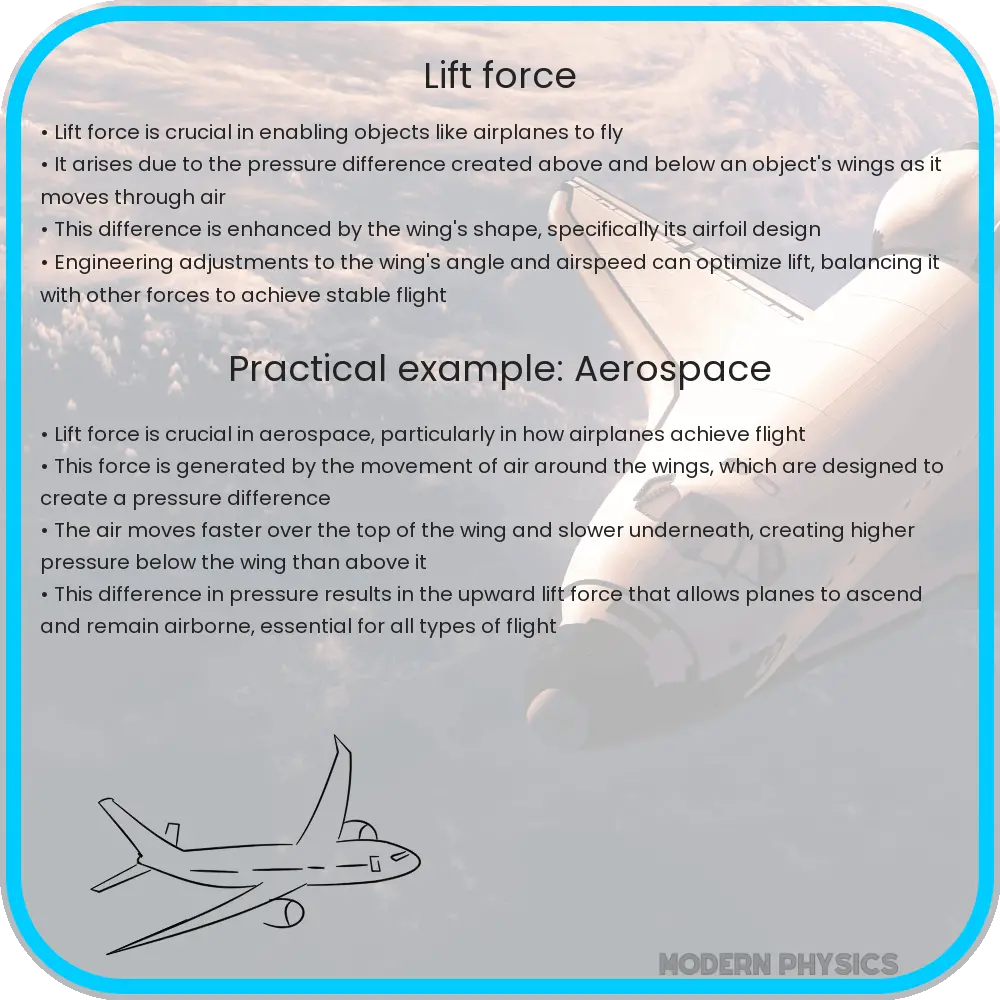Explore the principles, calculations, and diverse applications of lift force in dynamics, from aviation to natural phenomena.

Lift Force in Dynamics: Understanding the Principles
Lift force is a fundamental concept in the field of dynamics, playing a crucial role in various applications ranging from aeronautical engineering to sports physics. This force is responsible for the upward movement of objects against gravitational pull, particularly evident in the design and operation of aircraft.
Principles of Lift Force
The creation of lift force primarily involves the interaction between a solid body and a fluid, such as air or water. According to Bernoulli’s principle, an increase in the speed of the fluid occurs simultaneously with a decrease in pressure. This principle is vital in explaining how lift is generated. For instance, in aircraft wings, the air travels faster over the top surface than the bottom surface, creating a pressure difference that results in an upward lift.
Calculation of Lift Force
Lift force can be calculated using the formula: Lift = Coefficient of Lift (Cl) × Density of the fluid (ρ) × Velocity2 × Wing Area (A). The Coefficient of Lift (Cl) is a dimensionless number that represents the lift characteristics of the wing or airfoil. It varies with the angle of attack, shape of the wing, and the Reynolds number.
Application of Lift Force
Lift force finds applications in numerous fields. In aeronautics, it is essential for the takeoff, flight, and landing of aircraft. The design of wings and the entire aerodynamic structure of planes revolves around maximizing efficient lift. In the automotive industry, lift force principles are applied inversely to create downforce, which enhances vehicle stability and grip on the road. In sports, understanding lift force assists in optimizing the design and trajectory of balls in games like golf and soccer, where aerodynamic properties significantly influence performance.
Furthermore, the study of lift force extends to renewable energy, particularly in the design of wind turbines. The blades of a wind turbine are shaped like airfoils to maximize lift and, consequently, rotational speed, leading to more efficient energy generation.
Understanding the principles, calculations, and applications of lift force is crucial for advancements in technology and engineering. Its implications span across various sectors, underlining the importance of fluid dynamics in the modern world.
Advanced Considerations in Lift Force
In addition to the basic principles, advanced dynamics further explore the complexities of lift force. For example, the effects of turbulence, compressibility of air at high speeds, and boundary layer dynamics are crucial for more precise calculations, especially in high-speed aircraft and rockets. Computational Fluid Dynamics (CFD) has become an indispensable tool in analyzing these intricate factors, allowing for more accurate simulations and designs.
Lift Force in Nature
Nature also presents fascinating examples of lift force. Birds and insects have evolved wing shapes and flapping techniques that optimize lift for flight efficiency. Studying these natural phenomena has led to biomimicry in engineering, inspiring innovative designs in aviation and robotics.
Challenges and Future Directions
Despite the extensive understanding of lift force, challenges remain. For instance, minimizing the trade-offs between lift generation and energy consumption is a significant hurdle in aviation and automotive design. Additionally, the quest for sustainable and eco-friendly technologies in these industries often hinges on optimizing lift force while reducing emissions and noise pollution.
Future advancements in material science, aerodynamic theory, and propulsion technology will likely lead to breakthroughs in lift force application. Concepts like electric and solar-powered flight, supersonic and hypersonic travel, and even space exploration rely heavily on a deeper understanding and innovative application of lift force principles.
Conclusion
Lift force, a cornerstone concept in dynamics, showcases the intricate relationship between motion and force. Its principles not only govern the flight of aircraft and the performance of vehicles but also resonate in the natural world, influencing the design and function of living organisms. The study and application of lift force have led to remarkable technological and scientific achievements. As we continue to push the boundaries of physics and engineering, lift force remains a key subject, driving innovation and progress in various industries. Embracing its complexities and challenges, we can anticipate even more sophisticated and sustainable applications in the future, highlighting the ever-evolving nature of science and technology.
